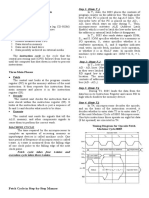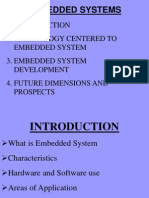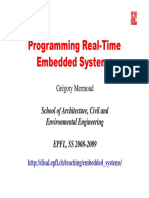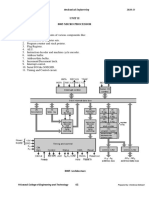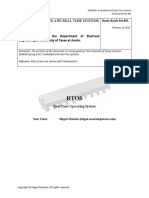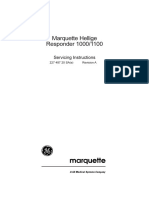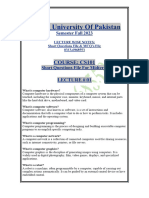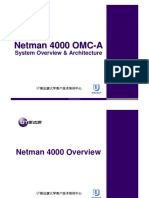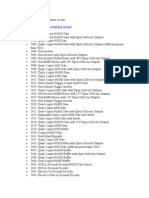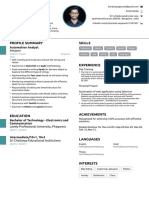Sistemas Embarcados e Tempo Real
Sistemas Embarcados e Tempo Real
Uploaded by
hilgadCopyright:
Available Formats
Sistemas Embarcados e Tempo Real
Sistemas Embarcados e Tempo Real
Uploaded by
hilgadOriginal Title
Copyright
Available Formats
Share this document
Did you find this document useful?
Is this content inappropriate?
Copyright:
Available Formats
Sistemas Embarcados e Tempo Real
Sistemas Embarcados e Tempo Real
Uploaded by
hilgadCopyright:
Available Formats
ME445M: Embedded and Real Time Systems
Lecture Set #01
EE445M: EMBEDDED AND REAL TIME SYSTEMS Lecture Set
#01
February 15, 2017
Course offered by the Department of
Electrical Engineering at University of Texas
at Austin
Disclaimer: The contents of this document are scribe notes for The University of
Texas at Austin EE445M Spring 2017, Embedded and real Time Systems.
RTOS
RealTimeOperatingSystem
Note Taker: Hilgad Montelo (hilgad.montelo@utexas.edu)
Copyright Hilgad Montelo. All rights reserved.
ME445M: Embedded and Real Time Systems
Lecture Set #01
RTOS Review
RTOS
Real Time Operating System is a software that manages computer system resources
like memory, I/O, data and processors, satisfying all time constraints.
HAL
Hardware Abstraction Layer. A software that simplifies porting application code from
one microcontroller to another.
Response Time or latency
It is the delay from request to the beginning of the service of that request.
Bandwidth
It is the number of information that can be transferred or processed (bytes/sec).
Embedded System
It consist of a smart device with a processor that has a special and dedicated
purpose.
For Embedded Systems, Real Time means that the embedded system must
respond to critical events with a strictly defined time (deadline).
There are 5 (five) types of software functions that the processor can perform in an
embedded system:
1. Mathematical or data processing operations.
2. Handling and managing time.
3. Real Tim input/output for measurement and control
4. DSP (Ex.: Audio, video, radar etc)
5. Communication and Network.
Embedded Systems are classified as:
Transformative: Collect data from inputs, makes decisions and affects its
environment by driving actuators (Ex.: Robots).
Reactive: Collects data from inputs in continuous fashion and produces outputs
in continuos fashion (Ex.: DSP).
Copyright Hilgad Montelo. All rights reserved.
ME445M: Embedded and Real Time Systems
Lecture Set #01
Common Embedded System Constraints:
- Small Size,
- Low weight,
- Low power,
- Harsh Environments,
- Safety Critical Systems
- Sensitive Cost.
Computer
It combines a CPU, Random Access memory (RAM), Read Only Memory (ROM), and
I/O ports.
Software
It is an ordered sequence of very specific instructions that are stored in memory,
defining exactly what and when certain tasks are to be performed.
Harvard Architecture
It has a separated data and instruction buses.
Interrupt
It is a hardware-triggered software function, which is extremely important for real
time embedded systems.
Latency of an interrupt Service
It is the time between hardware triggered and software response.
ARM Cortex-M Memory Access (bit banding)
Bit banding allow to read/write memory access.
Ex.01: What address do you use to access bit 3 of the byte 0x2000.1010?
Address = 0x2200.0000 + 0x20 x n + 4 x b
b=3
n = 0x1010
So,
Address = 0x2200.0000 + 0x20 x 0x1010 + 4 x 3 = 2202.020C
Copyright Hilgad Montelo. All rights reserved.
ME445M: Embedded and Real Time Systems
Lecture Set #01
Ex.02: What address do you use to access bit 7 of the byte 0x4000.0030?
Address = 0x4200.0000 + 0x20 x n + 4 x b
b=7
n = 0x0030
So,
Address = 0x4200.0000 + 0x20 x 0x0030 + 4 x 7 = 4200.061C
ARM Cortex-M Registers
R0-R12 General Purpose Registers.
R13 Stack Pointer (SP)
Note: there are 2 (two) stack pointers:
- Man Stack Pointer (MSP): Used for the Operating System
- Process Stack pointer (PSP): Used for the User Software.
R14 Link Register (LR). It stores the return location for the functions.
R15 Program Counter (PC). It points to the next instruction to be fetched
in memory.
The ARM Architecture Procedure Call Standard (AAPCS) part of the ARM Application
Binary Interface (ABI):
- Uses R0, R1, R2, R3, and R12 to pass input parameters into a C function or an
assembly sub-routine.
- The place to return parameter is R0.
- Preserve registers R4-R11, which implies save R4-R11, use them, and restore R4-
r11 before returning.
- Keep the stack aligned to 64 bits, by pushing and popping an even number of
registers (multiple of 8 bytes).
Special Registers:
- PSR (Program Status Register),
- Control Register
- PRIMASK*,
- FAULTMASK*,
- BASEPRI* * Exception mask Registers
ARM Program Status Register (PSR)
It contains the flags to represent the program status.
N Z C V Q I I/I T RESERVED ICI/ ISR Number
C T IT
31 3 2 28 27 26 25 2 2 2 2 2 1 1 1 1 15 1 1 1 1 1 9 8 7 6 5 4 3 2 1 0
0 9 4 3 2 1 0 9 8 7 6 4 3 2 1 0
N, Z, C, V, and Q represents status of ALU (Arithmetical and Logical Unit) operations.
Copyright Hilgad Montelo. All rights reserved.
ME445M: Embedded and Real Time Systems
Lecture Set #01
N Set if the result of a logical or arithmetical operation was
negative
Z If the result was zero
C If a carry happened
V If an overflow happened
Q If a saturation has occurred
T Arm is executing thumb instructions
ICI/T Used by interruptions and IF-THEN instructions
bit 0 of PRIMASK It is the interrupt mask bit or I bit. If is 1, most interrupt and
exceptions are not allowed; if is 0, interruptions are allowed.
STACK
A Last In First Out (LIFO) temporary storage.
Proper use of Stack requires the following rules:
1. Functions should have an equal number of pushes and pops.
2. Stack access should not be performed outside the allocated area.
3. Stack read and write should not be performed within the free area.
4. Stack push decrements SP then store data
5. Stack pop should first reads data then increment SP.
A bus fault will be generated when the software tries to read/write from an address
that does not exists. If a valid address below or above the stack, then further stack
operation will corrupt the data.
When multiple registers are pushed and popped, the data exists in memory with the
lowest numbered register using the lowest memory address (stacks top). Ex.:
If R1, R4, R5, R6 contains the values 1, 4, 5, 6 respectively, then the value of the
lowest numbered register R1 is placed in the lowest stack address.
If four entries are popped like POP {R0, R2, R7, R9}, the value the lowest stack
address is loaded in the lowest numbered register.
ARM Operating Modes
Arm Cortex-M processor has 2 privileged modes: privileged and unprivileged.
Bit 0 on Register Control is the thread Privileged Mode (TPL).
If TPL is 1 processor is in privileged mode. If TPL is 0 runs in unprivileged mode.
Bit 1 on the Register Control is the Active Stack Pointer Selection (ASPSEL).
Copyright Hilgad Montelo. All rights reserved.
ME445M: Embedded and Real Time Systems
Lecture Set #01
If ASPSEL is 1 then processor uses PSP.
If ASPSEL is 0 then processor uses MSP.
ARM Defines
- Foreground (main program) as thread Mode.
- Background (ISR) as handler Mode.
Switching between thread and handler mode is automatic.
The processor begins in thread mode, i.e. ISR_NUMBER = 0.
Whenever it is serving an interrupt, it switches to handler mode; i.e. ISR_NUMBER =
Interrupt being processed.
All ISR runs using the MSP stack pointer.
Note: The context is saved whichever stack pointer is active, but during the
execution of ISR, the MSP is used.
RESET
After a reset.
1. Processor is thread mode
2. Run in privileged mode
3. Uses MSP stack pointer
4. Load the 32 bit value located in position 0 of ROM into the SP
5. Load the 32 bit value located in position 4 of ROM into the PC
6. Thumb bit (T bit in Control register) is always 1 in Cortex-M.
7. LR is set to 0xFFFFFFFF.
I/O
Pin Specific wire on the microcontroller unit (MCU) that can be used for
specific input/output operations.
Port A collection of pins grouped by common functionalities
Interfa Collection of I/O ports, external electronics, physical devices, and
ce softwares.
I/O Interfaces
I/O interfaces can be classified in 4 (four) categories:
1. Parallel/Digital: Binary data available simultaneously on a group of lines.
2. Serial: Binary data is available 1 bit of the time.
3. Analog: Data are encoded as electrical, voltage or power.
4. Time: data are encoded as a period, frequency, pulse width or phase shift.
Copyright Hilgad Montelo. All rights reserved.
You might also like
- Final 8051 PrintoutDocument78 pagesFinal 8051 PrintoutArun Jyothi100% (1)
- By Getachew Teshome: Addis Ababa University, Department of Electrical and Computer EngineeringDocument17 pagesBy Getachew Teshome: Addis Ababa University, Department of Electrical and Computer EngineeringAnonymous AFFiZnNo ratings yet
- Int 1 Answer KeyDocument10 pagesInt 1 Answer KeyKavi PriyaNo ratings yet
- Unit 4 1Document17 pagesUnit 4 1K D PriscillaNo ratings yet
- EE3018-EP-QUESTION-BANK-2-marksnewDocument21 pagesEE3018-EP-QUESTION-BANK-2-marksnewNithiyanantham NagarajanNo ratings yet
- Microprosser 8085Document15 pagesMicroprosser 8085saigdv1978No ratings yet
- Virtualization II-2019-SysVMDocument47 pagesVirtualization II-2019-SysVM楊鎮維No ratings yet
- MM Assignmemt 2Document7 pagesMM Assignmemt 2ALL ÎÑ ÔÑÈNo ratings yet
- EMISY Second Test Exemplary Questions Solved-3Document15 pagesEMISY Second Test Exemplary Questions Solved-3YANG LIUNo ratings yet
- Question Bank For MPDocument38 pagesQuestion Bank For MPmekalajesiNo ratings yet
- MPMC SougataDocument5 pagesMPMC SougataSherlok HolmesNo ratings yet
- Lecture 7Document26 pagesLecture 7ShazidNo ratings yet
- Introduction To 8085 Architecture and Programming: Ifetce/It/Ii Year/ Iv Sem/IT141402/MPMC/ Ver 1.0 1Document89 pagesIntroduction To 8085 Architecture and Programming: Ifetce/It/Ii Year/ Iv Sem/IT141402/MPMC/ Ver 1.0 1Palani UthirapathyNo ratings yet
- An Over View of 8085Document12 pagesAn Over View of 8085nskprasad89No ratings yet
- ARM RTX Real-Time Operating SystemDocument67 pagesARM RTX Real-Time Operating SystemLauren LoveNo ratings yet
- Question Bank-Microprocessor and ApplicaionDocument38 pagesQuestion Bank-Microprocessor and Applicaionchandrasekar100% (5)
- Cheat SheetDocument3 pagesCheat SheetWei Xian Wong100% (3)
- Imp CoaDocument26 pagesImp CoatannazmuniNo ratings yet
- Microprocessor 8085 by Shaheen FatimaDocument17 pagesMicroprocessor 8085 by Shaheen Fatimaarun_21861208No ratings yet
- Computer Architecture IntroductionDocument20 pagesComputer Architecture IntroductionSamuelPopaNo ratings yet
- Program 8bitDocument20 pagesProgram 8bitraj6260578026kumarNo ratings yet
- Lab 2Document9 pagesLab 2Not meNo ratings yet
- 15EE305J Microcontroller LabDocument82 pages15EE305J Microcontroller LabEngr. Muhammad Shahid Laiq Research Associate NCAINo ratings yet
- Micro Notes - Chapter 2Document7 pagesMicro Notes - Chapter 2Haann NoiNo ratings yet
- Interview Level 8051 MCUDocument16 pagesInterview Level 8051 MCUkisam78442No ratings yet
- Microprocessor Lecture Notes 1 10Document202 pagesMicroprocessor Lecture Notes 1 10Ambarish SinghNo ratings yet
- 8051 Microcontroller (2 Marks - Question Bank)Document13 pages8051 Microcontroller (2 Marks - Question Bank)Dr. N.Shanmugasundaram97% (34)
- Chapter 04Document51 pagesChapter 04nghia7hNo ratings yet
- Two Mark MicroprocessorDocument18 pagesTwo Mark MicroprocessorGopinathan MNo ratings yet
- Unit I Microprocessor NotesDocument15 pagesUnit I Microprocessor NotesSaritha ReddyNo ratings yet
- CST307 - M3 Ktunotes - inDocument27 pagesCST307 - M3 Ktunotes - inriyafathimakp38No ratings yet
- 5 Sem Microprocessor NotesDocument77 pages5 Sem Microprocessor Notesitzmeappu420No ratings yet
- Computer Science (D9) XII - Paper - IIDocument8 pagesComputer Science (D9) XII - Paper - IIhelps7025No ratings yet
- Svcet: Sri Vidya College of Engineering & Technology Course Material (Question Bank)Document4 pagesSvcet: Sri Vidya College of Engineering & Technology Course Material (Question Bank)Balaprakash VadivelNo ratings yet
- Embedded SystemsDocument24 pagesEmbedded SystemsDileep KumarNo ratings yet
- BY Ajay Kumar & PutrDocument47 pagesBY Ajay Kumar & Putraj7007No ratings yet
- Ec2002 8085 L2,3,4Document35 pagesEc2002 8085 L2,3,4himadeepthi sayaniNo ratings yet
- Programming Real-Time Embedded Systems - EPFLDocument40 pagesProgramming Real-Time Embedded Systems - EPFLKhoa NguyenNo ratings yet
- MCT Unit 2Document26 pagesMCT Unit 2Aravind RajNo ratings yet
- Microprocessor and Interfacing: Authors:Ramesh.S.Gaonkar Badri Ram Douglas.V.Hall Liu and GibsonDocument52 pagesMicroprocessor and Interfacing: Authors:Ramesh.S.Gaonkar Badri Ram Douglas.V.Hall Liu and Gibsonavireddy1No ratings yet
- An Introduction To INTEL 8085 Microprocessor: By:Ravindra Nadh.V, Assistant Professor, GST, BangaloreDocument35 pagesAn Introduction To INTEL 8085 Microprocessor: By:Ravindra Nadh.V, Assistant Professor, GST, BangaloreVasudev Rao KonjetiNo ratings yet
- Introduction To The x86 MicroprocessorDocument102 pagesIntroduction To The x86 MicroprocessorysusmpNo ratings yet
- Introduction To The x86 MicroprocessorDocument102 pagesIntroduction To The x86 Microprocessormahi271286No ratings yet
- EC6504 MP Part A PDFDocument13 pagesEC6504 MP Part A PDFsenthilkumarNo ratings yet
- The 8086 Interrupt Mechanism: The 8259A PICDocument14 pagesThe 8086 Interrupt Mechanism: The 8259A PICSatishNo ratings yet
- Microprocessor and Its ApplicationsDocument25 pagesMicroprocessor and Its ApplicationsAbhishek SinghNo ratings yet
- Embedded Systems IntroductionDocument44 pagesEmbedded Systems IntroductionGokulSubramanianNo ratings yet
- Jurnal Tentang SD CardDocument4 pagesJurnal Tentang SD CardRyan IrfandiNo ratings yet
- Viva Questions and Answers in MP Lab - 1Document6 pagesViva Questions and Answers in MP Lab - 1Sai KrishnaNo ratings yet
- Microprocessor and Its ApplicationsDocument24 pagesMicroprocessor and Its Applicationssuperkan619No ratings yet
- Mpes Solved Dec 2017Document35 pagesMpes Solved Dec 2017masterjiynNo ratings yet
- Microprocessor Basics and Related TermsDocument27 pagesMicroprocessor Basics and Related TermsJai Sai RamNo ratings yet
- Hardware: Hardware For I/O - OverviewDocument17 pagesHardware: Hardware For I/O - Overviewosmanatam1No ratings yet
- 6016 4Document19 pages6016 4Ahmed QaziNo ratings yet
- Embedded Systems:: G P Computer SystemDocument21 pagesEmbedded Systems:: G P Computer SystemMonu ChouhanNo ratings yet
- Loyola Icam College of Engineering and Technology Department of Ece Cs 2252 Microprocessors and Microcontrollers Question Bank With AnswersDocument38 pagesLoyola Icam College of Engineering and Technology Department of Ece Cs 2252 Microprocessors and Microcontrollers Question Bank With AnswersKarthik KarthiksNo ratings yet
- Practical Reverse Engineering: x86, x64, ARM, Windows Kernel, Reversing Tools, and ObfuscationFrom EverandPractical Reverse Engineering: x86, x64, ARM, Windows Kernel, Reversing Tools, and ObfuscationNo ratings yet
- PLC: Programmable Logic Controller – Arktika.: EXPERIMENTAL PRODUCT BASED ON CPLD.From EverandPLC: Programmable Logic Controller – Arktika.: EXPERIMENTAL PRODUCT BASED ON CPLD.No ratings yet
- Lecture 6Document91 pagesLecture 6hilgadNo ratings yet
- EE382N-4 Advanced Microcontroller Systems: Embedded Software Optimization and Power Aware Software DevelopmentDocument31 pagesEE382N-4 Advanced Microcontroller Systems: Embedded Software Optimization and Power Aware Software DevelopmenthilgadNo ratings yet
- EE382N-4 Advanced Microcontroller Systems: Accelerators and Co-ProcessorsDocument75 pagesEE382N-4 Advanced Microcontroller Systems: Accelerators and Co-ProcessorshilgadNo ratings yet
- EE382N-4 Advanced Microcontroller Systems: Course OverviewDocument33 pagesEE382N-4 Advanced Microcontroller Systems: Course OverviewhilgadNo ratings yet
- Ee445M: Embedded and Real Time Systems: Study Guide Set #01Document4 pagesEe445M: Embedded and Real Time Systems: Study Guide Set #01hilgadNo ratings yet
- Ee445M: Embedded and Real Time Systems: Study Guide Set #01Document4 pagesEe445M: Embedded and Real Time Systems: Study Guide Set #01hilgadNo ratings yet
- Agilet's GSM GPRS ReferenceDocument882 pagesAgilet's GSM GPRS ReferencehilgadNo ratings yet
- Hardware in The Loop Simulation Underwater UnmannedDocument6 pagesHardware in The Loop Simulation Underwater UnmannedhilgadNo ratings yet
- VSDC Spring 2016 Homework 01Document12 pagesVSDC Spring 2016 Homework 01hilgadNo ratings yet
- A SA EN Responder1000Document56 pagesA SA EN Responder1000Marcos SanchezNo ratings yet
- (Michael Shur) Physics of Semiconductor DevicesDocument90 pages(Michael Shur) Physics of Semiconductor DevicesIshtiaque Navid0% (1)
- Programming Concepts and Skills Supported in ScratchDocument7 pagesProgramming Concepts and Skills Supported in ScratchvanjaurkeNo ratings yet
- Cs101 Lecture Wise Short Questions FileDocument44 pagesCs101 Lecture Wise Short Questions Fileroyalu101No ratings yet
- Car 1Document3 pagesCar 1VipinGuptaNo ratings yet
- Oracle Backup Recovery 18c Oracle Backup Recovery 18c em Oracle EnterpriseDocument200 pagesOracle Backup Recovery 18c Oracle Backup Recovery 18c em Oracle Enterprisesrsr1981No ratings yet
- Deploying Cisco Voice Over IP SolutionsDocument519 pagesDeploying Cisco Voice Over IP SolutionsAFS AssociatesNo ratings yet
- Hadoop LabDocument32 pagesHadoop LabISS GVP100% (1)
- TTS Presentation TMOSDocument40 pagesTTS Presentation TMOSAmit B MakNo ratings yet
- 1-NM4K - Training - OMC-A OverView & ArchitectureDocument27 pages1-NM4K - Training - OMC-A OverView & Architecturemazen ahmedNo ratings yet
- I17J 10.1 Inch Windows DatasheetsDocument2 pagesI17J 10.1 Inch Windows DatasheetsPrabhakar BhandarkarNo ratings yet
- Flip-Flop (Electronics)Document15 pagesFlip-Flop (Electronics)Vinay SinghNo ratings yet
- List of 7400 Series Integrated CircuitsDocument13 pagesList of 7400 Series Integrated CircuitsSalvador Flores TorresNo ratings yet
- Mvaa16 CortecDocument9 pagesMvaa16 CortecDinesh PanigrahiNo ratings yet
- Chandra Sekhar - Devops PDFDocument3 pagesChandra Sekhar - Devops PDFChandra Sekhar DNo ratings yet
- Kandula Sai Ganesh Automation Testing 2+ Yrs CTS BengaluruDocument1 pageKandula Sai Ganesh Automation Testing 2+ Yrs CTS BengaluruSneha RNo ratings yet
- MAGB1 User Guide, ENG V1.14, 29-3-2018Document50 pagesMAGB1 User Guide, ENG V1.14, 29-3-2018Haymee Torres GonzalesNo ratings yet
- PCATTCP Tools From MicrosoftDocument3 pagesPCATTCP Tools From MicrosofthuateeNo ratings yet
- LT2212Document15 pagesLT2212Sharafat KabirNo ratings yet
- Abb PLC 3adr020077c0204 Rev A PLC AutomationDocument234 pagesAbb PLC 3adr020077c0204 Rev A PLC AutomationSteve DennisNo ratings yet
- Dyre AnalysisDocument36 pagesDyre AnalysisAnonymous PF6GSFZPeENo ratings yet
- The Compiler, Assembler, Linker, LoaderDocument10 pagesThe Compiler, Assembler, Linker, Loadermahamd saiedNo ratings yet
- 20EC4104 Real Time Operating SystemDocument1 page20EC4104 Real Time Operating Systemd ramNo ratings yet
- Overview of Currently Available Books (Focus: Siemens Automation)Document3 pagesOverview of Currently Available Books (Focus: Siemens Automation)msvmsvNo ratings yet
- Hardware PracticalDocument65 pagesHardware Practicalnegigrv7500No ratings yet
- Cs 303: Computer Organization & ArchitectureDocument56 pagesCs 303: Computer Organization & ArchitectureHarsha VardhanNo ratings yet
- Hotcourses JavaDocument117 pagesHotcourses JavavishnuselvaNo ratings yet
- ACS850 Firmware Manual UIFI250x - enDocument378 pagesACS850 Firmware Manual UIFI250x - ensupermannonNo ratings yet
- 17bce0500 VL2019201001477 Ast02 PDFDocument6 pages17bce0500 VL2019201001477 Ast02 PDFRahul MangalNo ratings yet
- Assignment CN 2020-21Document4 pagesAssignment CN 2020-21study materialNo ratings yet























